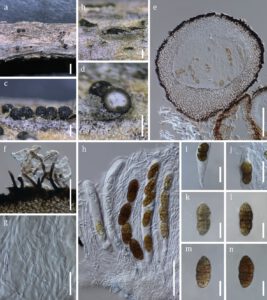Cucurbitaria berberidicola Appad., Gafforov, Abdurazakov & K.D. Hyde, Mycobank number: MB838444
(Processing in Phytotaxa with title: Morphological and phylogenetic insights reveal Cucurbitaria berberidicola (Cucurbitariaceae, Pleosporales) as a new species from Uzbekistan)
Description
Saprobic on dead stems of Berberis intermedia. Sexual morph: Ascomata 300–500 μm high × 300–480 μm diam. (x̅ = 360 × 358 μm, n = 5), solitary, gregarious, confluent, uniloculate, superficial, erumpent, subglobose to turbinate or pulvinate, sometimes laterally fused, black, setae on surface. Setae up to 90 μm long, 7 μm wide at the base, dark brown, septate with rounded ends. Ostiole central, short, slightly sunken, minute or inconspicuous at the surface, apapillate. Peridium 96–173 μm (x̅ = 133 μm, n = 10) wide at base, 55–105 μm (x̅ = 74 μm, n = 10) at sides, thickest at the base which often considerably elongated, outer most layer narrow, dark brown to black, opaque, warted, middle layer brown to dark brown cells of textura angularis to textura globulosa, inner layer composed pale brown to hyaline, flattened, cells of textura angularis. Hamathecium comprising numerous, 2–3 μm (x̅ = 2.4 μm, n = 20) wide, filamentous, hyaline, septate, branched, cellular pseudoparaphyses. Asci 140–200 × 16–24 μm (x̅ = 170 × 21 μm, n = 20), bitunicate, fissitunicate, 8–spored, cylindrical, short pedicellate, apex rounded with a narrow ocular chamber. Ascospores 28–38 × 15–18 μm (x̅ = 33.5 × 16.5 μm, n = 40), overlapping uniseriate, mostly ellipsoidal, muriform, with 8–12 transverse septa, 3–4 longitudinal septa, constricted at the middle transverse septum, not constricted at remaining septa, initially hyaline, brown to dark brown at maturity, ends rounded to subacute. Asexual morph: Undetermined.
Material examined: Uzbekistan, Jizzakh Region, Zaamin District, Zaamin National Nature Park, Turkestan range of Pamir–Alay Mountains, Uriklisay river, dead stems of Berberis intermedia (Berberidaceae), 15 July 2019, Y. Gafforov & A. Abdurazakov, YG–Z70–1 (TASM 6153, holotype; HKAS 111925, isotype), ex–isotype living culture KUMCC 20–0253.
Distribution: (Uzbekistan)
Sequence data:
ITS: MW444858 (ITS1/ITS4); LSU: MW444859 (LROR/LR5); RPB2: MW462109 (fRPB2–SF/fRPB2–7cR); tef1–α: MW462110 (EF1–983F/ EF1–2218R)
Notes: Cucurbitaria berberidicola resembles C. berberidis in its asci and ascospore characteristics (Doilom et al. 2013). Cucurbitaria berberidicola differs from C. berberidis in having less crowded ascomata which bear setae, less–warted peridium, narrower peridium base (with the widest area reaching 173 μm compared to 420 μm), and up to 12 transverse septa on its ascospores (TABLE 3). Cucurbitaria berberidicola also resembles C. oromediterranea but differs in the ascomatal and ascal morphology (Jaklitsch et al. 2018). C. berberidicola bear setae on the ascomata, are less crowded and can be solitary in their distribution. Cucurbitaria berberidicola has also smaller and smoother surface ascomata, smaller peridium at the base at the sides, and slightly shorter asci (TABLE 3), which lacks a knob–like structure at the base of the ascus stipe.
From our multi–loci phylogenetic analyses C. berberidicola positioned basal to C. oromediterranea and C. berberidis, with 98% MLBS / 100% MPBS / 1.00 BYPP bootstrap support (Figure 1). Pairwise comparisons between C. berberidicola and the ex–type strain of C. berberidis (CBS 130007) showed 3.20% (15/468), 0.25% (2/799), 8.34% (89/1067) and, 3.20% (23/718) base pair differences for ITS, LSU, rpb2 and tef1–α sequences, respectively. There are also 2.77% (13/468), 0.25% (2/799), 8.34% (89/1067) and 3.06% (22/718) base pair differences between C. berberidicola and ex–type strain of C. oromediterranea (CBS 142399) for ITS, LSU, rpb2 and tef1–α sequences, respectively.
Figure 1 . Cucurbitaria berberidicola (TASM 6153, holotype). a–c. Ascomata on substrate. d. Horizontal section of an ascoma. e. Vertical section of ascoma. f. Setae. g. Pseudoparaphyses. h. Asci embedded in pseudoparaphyses. i. Pedicel of an ascus. j. Ascus tip showing ocular chamber. k–n. Ascospores. Scale bars: a = 1000 μm, b = 500 μm, c= 500 μm, d = 500 μm, e = 100 μm, f = 100 μm, g = 10 μm, h = 50 μm, i–n = 20 μm.

